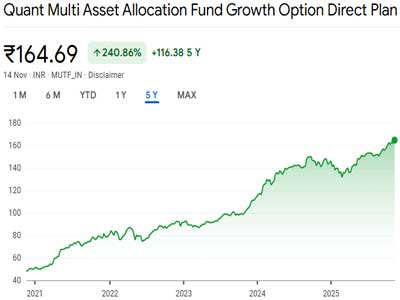The ‘Quant Multi Asset Allocation Fund Regular Plan Growth’ fund is known for its active, model-driven, and tactical approach to asset allocation. This fund uses a proprietary VLRT Framework, i.e. Valuation, Liquidity, Risk Appetite, and Time, to identify cross-asset and cross-market inflexion points. This allows the fund to dynamically shift its allocation between Equity, Debt, and Commodity, sometimes with ‘near-aggressive speed’, which has been cited as a reason for its outperformance against peers.
Remember, Multi-Asset Allocation funds are mandated to invest in at least three asset classes: Equity, Debt, and Commodity. This diversification is designed to reduce overall portfolio volatility and capture returns across different market cycles. Here, Equity provides growth potential, Debt offers stability and income, while Commodities provide a hedge against inflation and economic uncertainty.
The ‘Quant Multi Asset Allocation Fund Regular Plan Growth’ fund has demonstrated exceptional historical performance, which contributes to positive future sentiment, although this is not indicative of future returns.
Over the past 5 years, the fund has delivered a Compound Annual Growth Rate significantly higher than its category average and blended benchmark. This consistent outperformance suggests the quantitative model has been highly effective in recent cycles. Some analyses suggest the fund has delivered exceptional returns for a Moderate and High-Risk profile, making it a compelling option in the Hybrid category.
The fund has a high turnover ratio, which is consistent with its active and dynamic asset rotation strategy. This suggests the fund managers are constantly adjusting the portfolio based on their models.
The fund's performance is highly reliant on the proprietary models' ability to accurately forecast market turning points and allocate assets accordingly. If the models continue to deliver accurate signals in varied economic environments, the fund should perform well.
Multi-asset funds benefit from non-correlated asset movements. Its performance will rely on the fund's ability to timely rotate into the best-performing asset class, i.e. Equity, Debt, or Commodity, in the future. For example, its current exposure to commodities like Silver ETF offers a unique hedge.
Multi-asset funds are often recommended for times of market uncertainty. The dynamic allocation can help cushion the portfolio during sharp corrections, offering relatively smoother returns than a pure equity fund.
The Regular Plan generally has a higher expense ratio than the Direct Plan. Over the long term, this higher cost will impact the net returns for the investor compared to the Direct Plan.
Overall, the Quant Multi Asset Allocation Fund Regular Plan Growth is characterised by a highly active and quantitative-driven strategy that has resulted in superior returns historically. It may be suitable for long-term investors seeking a single fund solution for diversification across Equity, Debt, and Commodities. Also, it may better suit the investors who prefer a systematic, non-discretionary, and dynamic management style rather than traditional fundamental-driven stock picking.
Investors with a High-Risk appetite who can tolerate the fast-moving portfolio shifts and higher volatility compared to a static balanced fund should consider this fund should be in their portfolio.
Disclaimer: The prospects of any mutual fund are subject to market risks, and past performance is not a guarantee of future results. Any Stock, Mutual fund, trading calls or information is for informational purposes only and is not an offer to buy or sell securities or investment advice. It emphasises that all investment decisions are at the user's own risk and may result in the loss of capital. Users should not rely solely on this information but conduct their own independent research before making any investment decisions.

















Related Items
BSNL offers a mobile plan dedicated to students
When treatment becomes a profit-driven business…
Will caste and religious walls collapse in Bihar this time…?